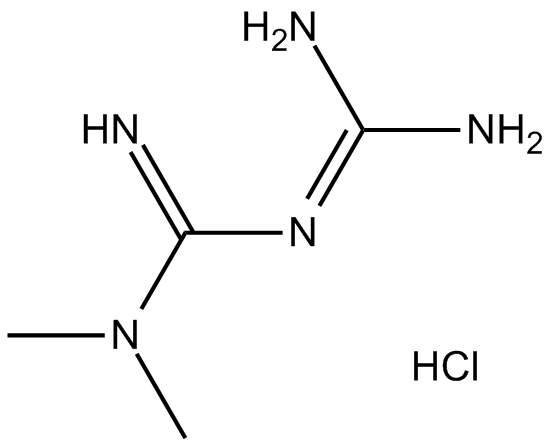Metformin HCl (Synonyms: 1,1-Dimethylbiguanide hydrochloride) |
| Catalog No.GC17443 |
Metformin HCl (1,1-Dimethylbiguanide hydrochloride) inhibits the mitochondrial respiratory chain in the liver, leading to activation of AMPK, enhancing insulin sensitivity for type 2 diabetes research.
Products are for research use only. Not for human use. We do not sell to patients.

Cas No.: 1115-70-4
Sample solution is provided at 25 µL, 10mM.
Metformin HCl is one of the most effective and widely used therapeutics for treatment of type 2 diabetes. It selectively lowers the hepatic gluconeogenesis without rising insulin production, causing weight gain or hypoglycemia. [1]
AMPK (5'AMP-activated protein kinase) acts as a metabolic master switch regulating several intracellular systems including the cellular uptake of glucose, the β-oxidation of fatty acids and the biogenesis of GLUT4 (glucose transporter 4) and mitochondria.
In hepatocytes, AMPK was activated by metformin, followed by decreased ACC (acetyl-CoA carboxylase) activity, induction of fatty acid oxidization and suppression of lipogenic enzyme expression.[2] Metformin also inhibited mGPD (mitochondrial lycerophosphate dehydrogenase),a redox shuttle enzyme, leading to an altered hepatocellular redox state, decreased conversion of lactate and reduced hepatic gluconeogenesis. [1]
In rats treated with metformin, hepatic expression of SEREP-1 mRNAs/protein and activity of ACC were reduced. [2] In metformin treated mice, LKB1 in liver was essential for the ability of metformin to reduce blood glucose [3]. In ASO (Antisense oligonucleotide) knockdown of hepatic mGOD in rats, the phenotype was similar to chronic metformin treatment. It abolished mefromin-induced cytosolic redox state, reduction in plasma glucose concentration and EGP inhibition. [1]
References:
1. Madiraju AK, Erion DM, Rahimi Y et al. Metformin suppresses gluconeogenesis by inhibiting mitochondrial glycerophosphate dehydrogenase. Nature. 2014 Jun 26;510(7506):542-6.
2. Zhou G, Myers R, Li Y et al. Role of AMP-activated protein kinase in mechanism of metformin action. J Clin Invest. 2001 Oct;108(8):1167-74.
3. Shaw RJ, Lamia KA, Vasquez D et al. The kinase LKB1 mediates glucose homeostasis in liver and therapeutic effects of metformin. Science. 2005 Dec 9;310(5754):1642-6.
Average Rating: 5 (Based on Reviews and 17 reference(s) in Google Scholar.)
GLPBIO products are for RESEARCH USE ONLY. Please make sure your review or question is research based.
Required fields are marked with *




















